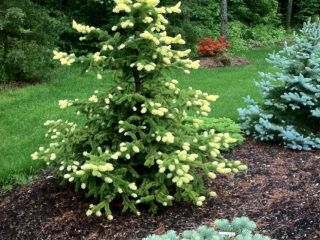Content
Diseases of spruce trees are of bacterial and viral origin. To quickly cope with ephedra ailments, you need to carefully study their symptoms and characteristics.
Reasons for appearance
Spruce is popular in landscape design, but is quite often affected by pests and fungi. This causes great damage to the decorative appearance of the conifer - the needles of the tree dry out, the cones fall off, and plaque appears on the branches.
Most often, diseases and pests affect spruce:
- due to the presence of pathogenic microorganisms in the soil;
- against the background of excessive watering;
- due to unsuitable soil composition;
- due to an incorrectly chosen place for planting;
- due to excessive deepening of the seedling;
- due to lack of light.
Diseases more often affect conifers that grow too closely together. In such cases, infections quickly spread from tree to tree.
Diseases of spruce trees and their treatment
There are a lot of diseases of prickly spruce. In order to treat a tree against ailments in a timely manner, you need to become familiar with their symptoms.
Schutte
The common spruce disease usually appears in early spring.The needles on last year's shoots begin to turn brown or red, die, but do not fall off and remain in place for a long time. Over time, black shiny dots appear on the needles at the bottom - apothecia of the fungus. Spruce trees affected by Schutte grow worse and often die, especially if young seedlings are affected by the disease.

Spruce in the middle zone is affected by both common and snow shutte
At the first symptoms of the disease, the ephedra is subjected to sanitary pruning and sprayed with a fungicidal solution. Copper sulfate and Bordeaux mixture are good for chute. To reliably get rid of the disease, it is worth carrying out the treatment 3-4 times at short intervals.
Spruce rust
Another fungal disease of spruce cones and needles affects ornamental trees in early summer. Golden cylindrical growths no more than 3 cm in diameter appear on the green needles. After ripening, the bubbles burst and release spores that scatter throughout the area. An ephedra affected by rust loses its decorative properties and slows down its development, sheds its crown and gradually dies.

To prevent spruce rust, it is important to remove weeds from the area in a timely manner.
If characteristic growths appear on the needles, you need to trim the tree and burn the plant debris in the far corner of the garden. The ephedra is sprayed with 1% Bordeaux mixture or a similar fungicidal preparation. Treatments are carried out once every two weeks until symptoms disappear completely.
Fusarium
The disease affects conifers most often on clayey, swampy soil with poor drainage. The infection primarily affects the roots; the needles first turn red, and then dry out and fall off. As the disease progresses, the spruce branches die, the crown becomes sparse and ugly.

To prevent fusarium disease, you should avoid planting spruce in lowlands.
Treatment of fusarium is carried out using the drugs Fundazol or Fitosporin-M. Fungicidal solutions are used to water the tree at the root. At the same time, it is important to eliminate waterlogged soil, which contributes to the development of diseases. If a tree grows in a bad place, it is better to dig it up and plant it in another area before starting treatment.
Lichens
Lichens are a plant organism that enters into symbiosis with conifers. They especially often settle on weakened specimens and can be found in several varieties on one tree. Since lichens densely cover the trunk of the plant and actively absorb moisture and air, as a result of their vital activity, the respiratory processes of the spruce itself are disrupted. The ephedra begins to grow more slowly, its crown ceases to renew itself normally. Insects and microorganisms can live under lichens, which also pose a danger to spruce.
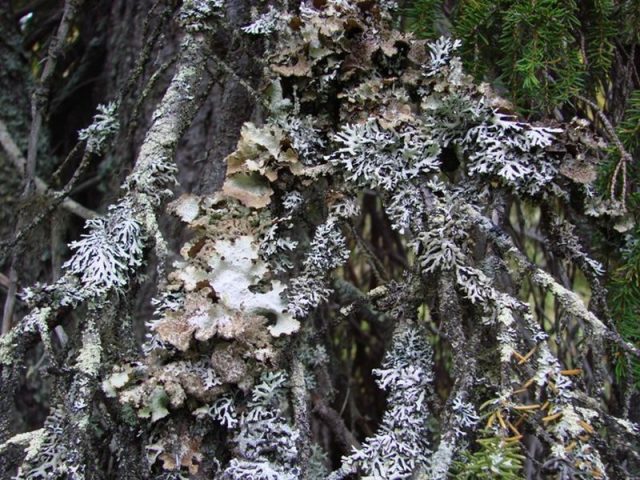
Lichens on conifers appear at high humidity
To cure a tree, you need to remove all the dead branches, and then use a stiff sponge or rough glove to clean the bark on the trunk. Then the spruce is treated with HOM or Abiga-Peak twice with a two-week break. The wounds remaining on the trunk should be sprayed with 5% copper sulfate, and after drying, covered with oil paint.
Root sponge
The infectious conifer disease affects the underground system of spruce. Leathery brown or brownish formations appear on the lower surface of the roots and near the base of the trunk, light yellow or white when cut. The structure of the growths is cork-like, soft, which explains the name.
The root sponge has a destructive effect on the wood of the roots and trunk. Nutrition processes are disrupted and the spruce tree quickly dies. The plant can be saved only in the early stages of the development of the disease if foci of infection are removed and problem areas are treated with copper sulfate.

Root sponge infection can travel up to 10 m up a spruce trunk
Cancer diseases
A great danger to ornamental spruce is cancer that affects branches and trunks. Wounds of various types are formed on the shoots of the plant - elongated and wide, stepped, with smooth or pointed edges. Usually the damage is located in the lower part of the trunk.
With the rapid progression of the disease, the ulcers grow greatly in a short time, and a large amount of fresh and dried resin can be seen inside. If the cancer develops slowly, the damage is minor or consists of closed sagging of wood, partially or completely covered with bark.

Cancerous ulcers on the spruce trunk appear as a result of mechanical injuries, frost damage and burns
The disease is difficult to treat. Treatments with fungicidal agents can slow down the development of the disease, but do not eliminate it completely. The focus needs to be on prevention. It is important to carry out sanitary pruning for spruce in a timely manner and remove all frozen and damaged branches, as well as prevent the spread of pests.
Powdery mildew
Powdery mildew on conifers appears in damp but warm weather, and especially often damages trees growing close to each other. You can recognize the disease by the thick white coating on the needles.Over time, the needles darken and fall off, the spruce's immunity decreases and frost resistance decreases.
When symptoms of powdery mildew appear, the tree should be sprayed with Bordeaux mixture or copper sulfate. It is important to carry out the treatment in dry and sunless weather so that the solution does not leave burns on the needles.
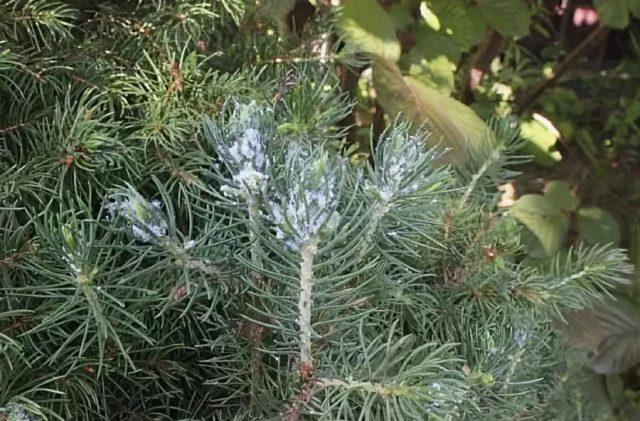
Spruce powdery mildew develops more often on highly acidified soil
Shoot necrosis
The fungal disease can be recognized by small black dots on the needles, which over time turn into a grayish coating. Spruce affected by necrosis turns yellow, its needles fall off, and its shoots dry out and become deformed. Fungal spores remain in plant debris for a long time.

Necrosis mainly affects young shoots of spruce
In the early stages of the development of the disease, treatments with Fundazol, Abiga-Peak and HOM are beneficial. During the summer, it is advisable to carry them out 2-3 times at intervals of 14 days. Dried shoots of spruce need to be eliminated, and the cuts should be covered with oil paint to prevent rotting.
Pests of spruce trees and their control
Pests of spruce cones cause no less damage to the plant than fungal diseases. Parasites can destroy a tree in just one season if there is no fight.
Spider mite
The spruce pest feeds on the sap of needles and leaves a web on the shoots and needles of the tree. Under the influence of the parasite, the plant turns yellow, the greenery fades to almost a whitish hue. The pest appears in dry and hot weather; in damp summers there is no need to fear its invasion.
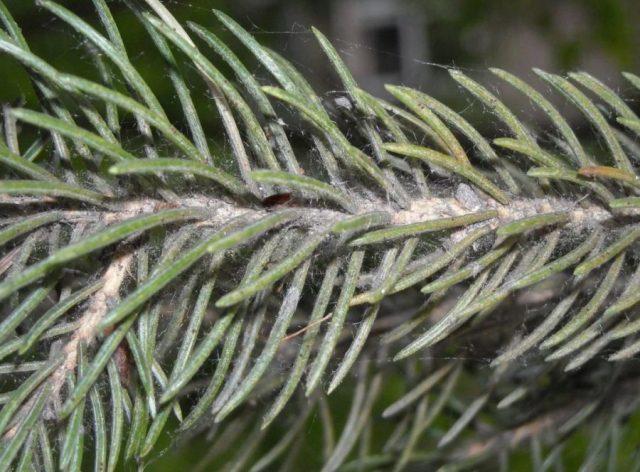
Spraying the spruce tree with water over the crown helps prevent the appearance of spider mites.
It is necessary to combat spider mites with Flumite, Apollo or Borneo. Agravertin and Actellik also bring good results.Pest treatments are usually carried out 2-3 times per season in accordance with the instructions.
Aphid
The dangerous parasite also feeds on spruce plant sap and weakens the tree. The pest multiplies very quickly and spreads throughout the coniferous forest in large colonies, and green insects are almost invisible. The presence of a parasite can be suspected by the appearance of yellow spots and a sticky coating on spruce needles.

Aphids not only directly harm spruce, but are also carriers of dangerous viruses.
You need to fight aphids on spruce with the help of ready-made insecticides - Aktara and Aktellika. If there are few parasites, you can also use a homemade solution of laundry soap. It is recommended to begin treatment at the first symptoms, before the pest has caused significant damage and led to the development of fungal diseases.
Spruce sawfly
The small spruce pest reaches approximately 6 mm in length and has a dark or yellowish oblong body. It mainly affects young trees, but can also settle on plants older than 10-30 years. Under the influence of the pest, the needles on spruce shoots turn red. For a long time, the needles continue to stay on the branches, but then they still fall off.
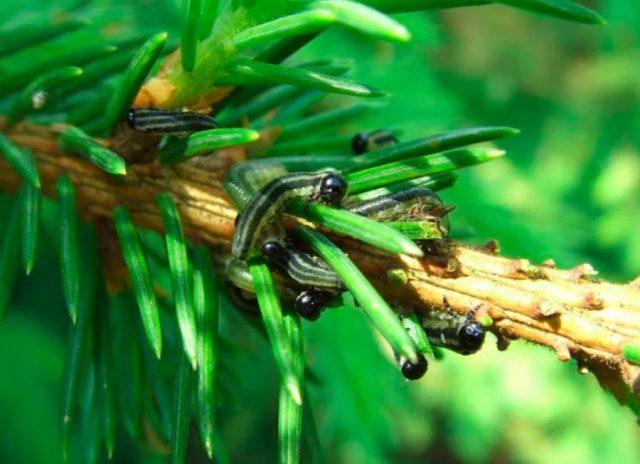
The spruce sawfly pest overwinters in the soil and tolerates cold well
You can treat spruce against pests with Actellik and Decis. It is also necessary to carefully dig up the soil in the tree trunk circle to destroy the oviposition of the parasite.
Spruce moth
A small gray pest with white streaks on its wings, it attacks conifers in early summer. When infected, cobwebs appear on the spruce needles, then the greenery falls off and the branches become bare.If there are a large number of pests, the shoots may also bend and dry out.
Spruce moth lays eggs directly on the needles and in the axils. The main danger to the plant is the caterpillars of the pest. They gnaw passages in the young bark and disrupt the feeding processes of spruce, slow down its growth and impair its endurance.

To prevent moths, it is useful to spray spruce with Zircon solution
Bark beetle typographer
The pest reaches 5.5 mm in length and has a shiny brown body. It settles in the bark of spruce trees and gnaws small holes in it; as a result, the trunk is covered around the circumference with brownish flour. The bark beetle makes passages in the wood and makes chambers where females lay eggs. The emerging pest larvae continue to move deeper into the trunk, eating the spruce from the inside.
The bark beetle is very difficult to see with the naked eye. But its presence can be suspected by the yellowing and falling of the needles, as well as marks on the surface of the trunk. The fight against the parasite is carried out using insecticides - Aktellika, Iskra, Aktary. You need to start treatment as quickly as possible, before the pest destroys the entire coniferous planting.

The bark beetle pest begins to be active after the temperature reaches about 18 ° C
Great spruce beetle
A large beetle up to 1 cm in length has a shiny black body and reddish antennae and paws. There are long yellow bristles on the body. The pest feeds mainly on old and weakened spruce trees, but can attack young seedlings.
Like the typograph beetle, the pine beetle gnaws through bark and eats wood. The easiest way to recognize the presence of a pest is by the redness of the needles and the appearance of resinous holes on the trunk. You can remove the pine beetle using the drugs Aktara and Decis.Spraying is carried out along the trunk and shoots at least twice a season.

The greater pine beetle most often affects European, Ayan and Siberian spruce
Hermes
The yellowish-green small insect has a body only about 2 mm in length. It feeds on the juices of pine needles, causing the needles to fade and fall off. You can find out about the infection by the appearance of galls on the spruce - first beige and green, and then brown-black. The shoots on which growths have formed dry out over time and then die.

Hermes more often affects spruce if there are fir and larches in the area
It is necessary to spray the spruce from Hermes with Confidor, Karate or Decis, as well as with preparations containing paraffin oils. In addition, it is recommended to remove and burn galls left by the pest.
Mealybug
The pest has a wide white body up to 7 mm in length and numerous legs. It multiplies quickly and can destroy a spruce in 2-3 years. The presence of a pest can be easily determined by the presence of a cotton-like white coating on the trunk and shoots.

Female mealybugs can lay up to 2,000 eggs per summer
Mealybugs lay eggs in cracks in the bark and forks of spruce branches. During its life, the pest produces sticky honeydew, on which sooty fungus often develops. To combat insects, the insecticides Arrivo and Actellik, as well as Karbofos and Fufanon, are used.
Preventive measures
Treating spruce against pests and fungi does not always give a good effect. First of all, you need to pay attention to prevention:
- do not allow the soil to become waterlogged in the area with spruce;
- carry out sanitary pruning for the plant in a timely manner;
- regularly dig up the soil and destroy the remains of pine needles and dry branches;
- in the fall, preventively treat the soil at the roots of spruce with fungicides and insecticides;
- from time to time apply complex mineral fertilizers;
- in early spring, spray the crop with copper sulfate along the crown.
When growing spruce on your property, you need to regularly inspect the tree in order to promptly notice the first symptoms of disease. It is necessary to treat all cracks and ulcers on the trunk with garden varnish and annually clean the bark of lichens.
Conclusion
Diseases of spruce trees develop with insufficient care of the plant and against the background of unsuitable conditions. In the early stages, diseases and pests of conifers can be combated with inexpensive but effective drugs.








